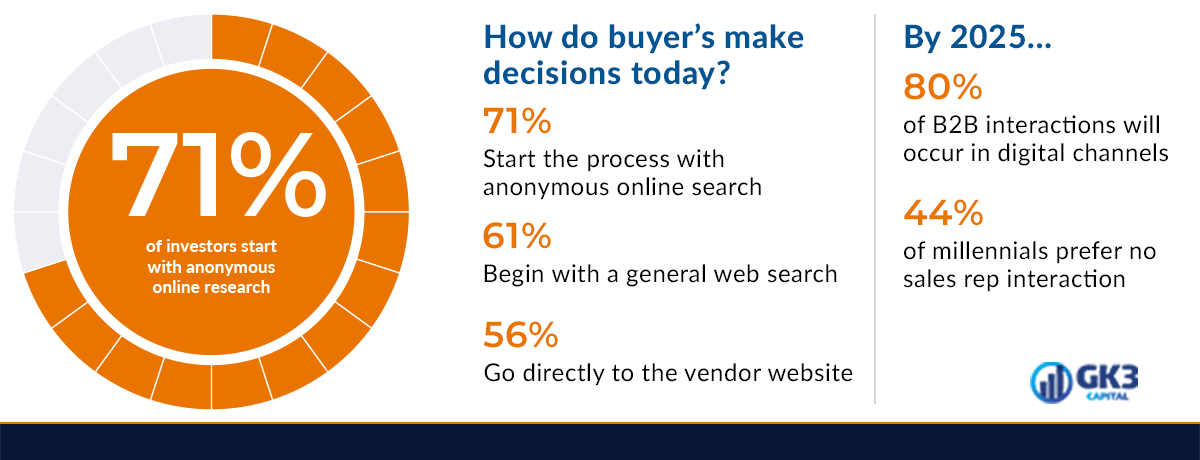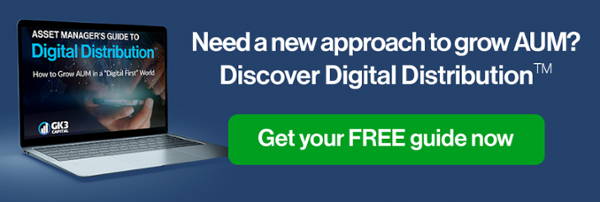The old rules and approaches to distribution no longer work. I learned this by speaking with asset management sales and marketing teams across the US, who were learning this the hard way.
Several years ago, I was recruited to serve as Executive Vice President of a well-known financial technology company. My mission was to build a consulting business dedicated to helping asset managers accelerate growth through the power of data. Every client—big, small and in between—was struggling with the same challenges:
- Advisors no longer answered the phone.
- Wholesalers couldn’t get as many appointments as they needed or once could.
- Competition was fierce.
- The cost of raising capital continued to increase.
All asset managers were trying to figure out how to solve their distribution challenges.
Solving this challenge became my new mission.
How to Thrive in a Digital World
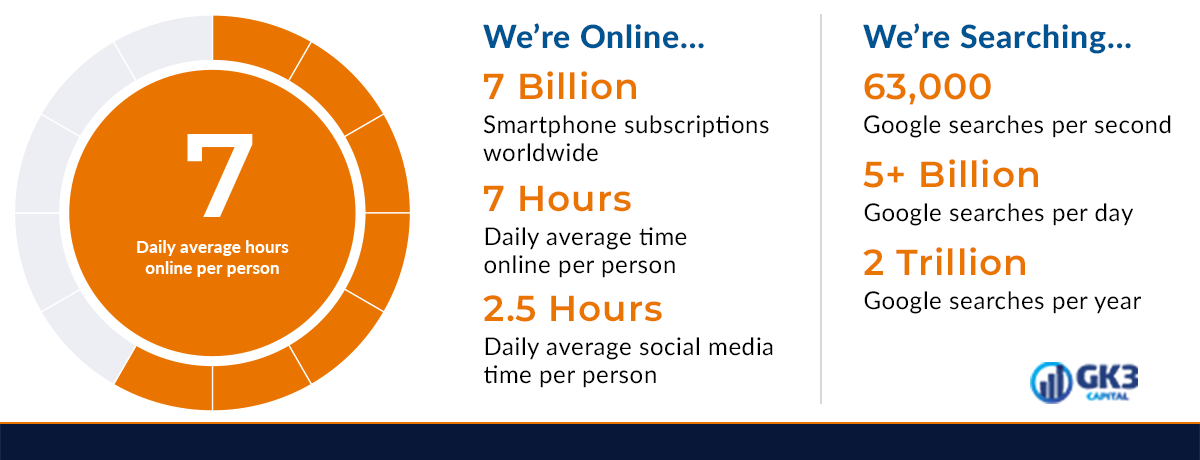
Worldwide, people spend an average of 7 hours each day on the internet, including 2.5 hours on social media. Globally, smartphone subscriptions are approaching 7 billion. Collectively, we input 63,000 Google searches every second, equal to over 5 billion searches per day and 2 trillion searches per year.
We’re Online
- 7 billion smartphone subscriptions worldwide
- 7 hours daily average time online per person
- 2.5 hours daily average on social media per person
We’re Searching for Answers
- 63,000 Google searches each second
- 5+ billion Google searches each day
- 2 trillion Google search each year
The Digital Imperative for Business
The world has gone online, and so has business. How do buyers make decisions today? The statistics from the DemandGen “2017 B2B Buyer’s Survey Report” illuminate the growing challenges for business-to-business industries triggered by changes in buyer behavior:
- 71% of business-to-business buyers start their purchase process with anonymous online research.
- 61% begin with a general web search.
- 56% go directly to a specific vendor website.
With buyers initiating their purchasing process online and anonymously, old approaches to sales no longer work.
“The Future of Sales,” a recent groundbreaking report from Gartner, the technology research and consulting firm, tells us where we’re heading:
- 80% of B2B sales interactions will occur in digital channels by 2025.
- 44% of millennials, the first digital native generation, prefer no sales rep interaction for business-to-business purchases.
All around us, buying behavior has changed and continues to transform in our interconnected world. Consumers and investors make decisions based on digital engagement and online content. Most importantly, for the asset management industry, investors complete most of their research and buying process online before talking to a human (if at all). Asset managers must adapt, but our industry generally lags.
Asset managers must now create and curate a complete digital experience to attract and retain clients. This digital experience encompasses interactive websites, fresh insightful content, a dynamic online presence, a seamless user interface, digital outreach, and automated marketing and sales systems—all compliant, too. Asset managers who provide the digital experience that investors seek are rewarded with personal engagement and sustained asset flows.
You Must Learn Two Languages
Successful fundraisers today must learn to speak two languages: distribution and digital. Winning distribution teams will combine expertise in digital practices with core distribution skills. Positive asset flows await those who combine digital and distribution excellence by recruiting—or outsourcing—the necessary talent and resources.
Digital Distribution Defined
Digital distribution is how to grow assets in a digital world. Digital distribution is a systematic and scalable solution and the future model for distribution in the asset management industry. Digital distribution represents digital transformation for asset managers.
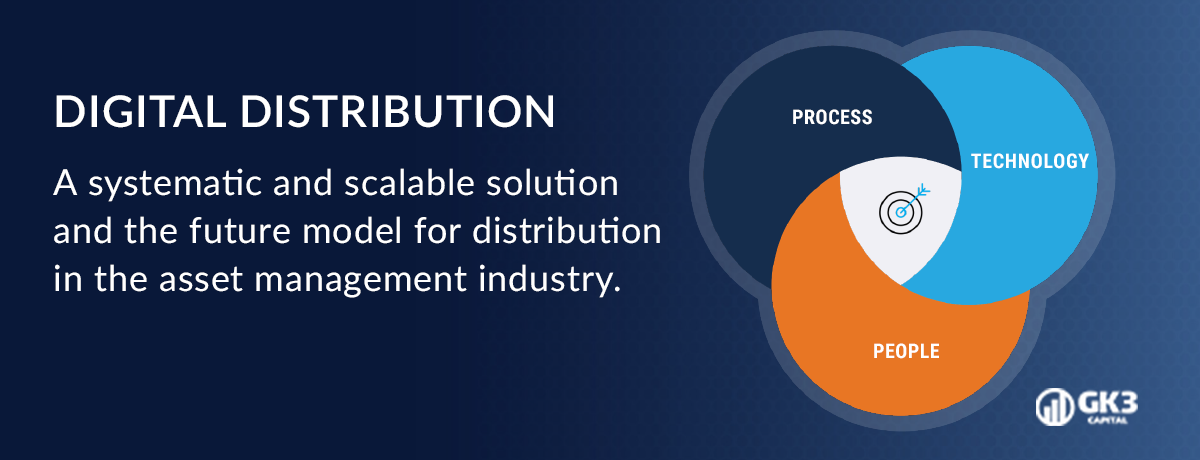
Digital distribution stands upon three fundamental pillars. To successfully implement each pillar, and achieve the powerful synergies when the elements are combined effectively, you must understand the answers to three critical questions:
- Process: What process makes digital sales and marketing effective?
- Technology: What tech stack and tools are required?
- People: What skills, talents, and team dynamics are needed to succeed?
The Process: For Inflows, Go Inbound
In a digital world, what does it take to generate inflows? Inbound is the roadmap for growing your business in a digital world that aligns with how investors and advisors make investment decisions today. Inbound is the underlying process for digital distribution.
What is inbound sales and marketing? Inbound is about attracting the right potential clients with digital content that engages, educates, and provides solutions to their challenges. Inbound is about pulling your ideal customer to you.
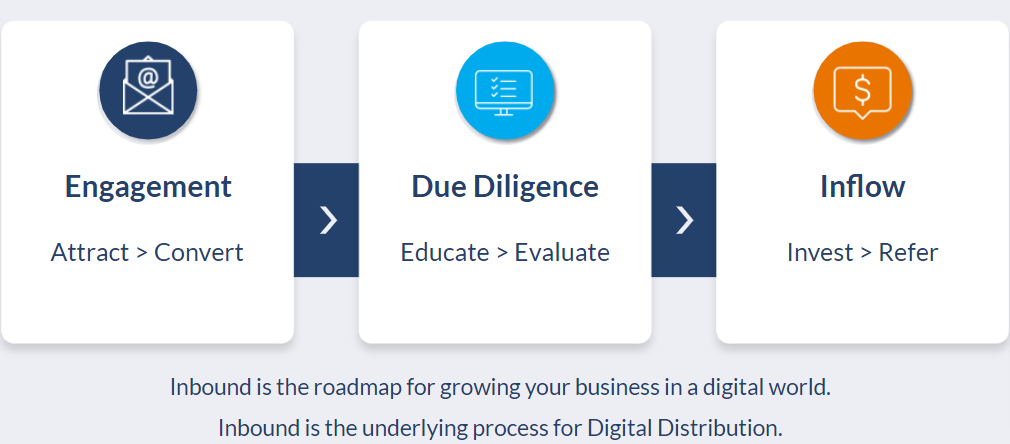
Today, when your clients have a problem, they are unlikely to speak with a salesperson first. With information at our fingertips, relationships now begin on the other side of a Google search, website visit, or social media post.
Thus, you must earn an investor’s attention and trust online. You can accomplish this by sharing your knowledge and guiding an investor to a more informed decision. As you become a trusted resource, investors are more likely to work with you, rather than someone who hasn’t made the effort to know them and to help them.
Critically, asset managers must build their marketing and sales strategy to align with how we make decisions today. We need to optimize our online presence. We need to capitalize on each potential advisor or investor engagement. We must continually create content that educates our potential clients on how we are the solution to their challenges.
What Inbound is Not
Inbound is not the opposite of outbound, nor is it a passive approach. Inbound is richly proactive, combining ongoing content generation with consistent outreach—which can culminate with outbound activity. For example, an inbound strategy can identify a likely buyer who consistently engages with your content. This engagement provides signals of buyer intent on your website. When the signal is strong, that’s the time right for the sales team to engage. An outbound call from the sales team may be a timely next step.
Liberation
Inbound liberates asset management sales professionals to focus on their most value-added activity—serving qualified and interested investors at the right time and bringing in new assets.
Upcoming Posts
In our upcoming posts, we will delve into the component steps of the inbound approach, and explore the tech stack, team, and talents needed to succeed.
Learn More
Are you considering digital transformation for your distribution effort? Do you want to explore how to implement a digital distribution strategy? To learn more, download our free eBook: “Asset Manager’s Guide to Digital Wholesaling.”
Topics: Content Digital Marketing Digital Distribution Asset Management Website Sales Enablement CRM Automation Lead Generation Technology


.png)
